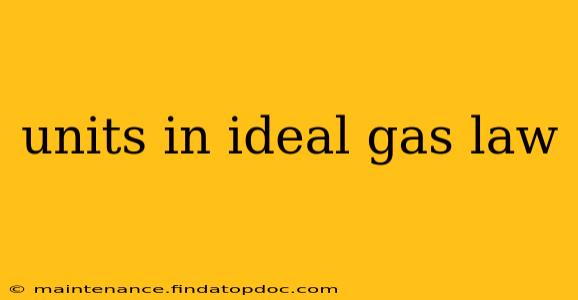The Ideal Gas Law, PV = nRT, is a cornerstone of chemistry and physics, describing the behavior of ideal gases. Understanding the units involved is crucial for accurate calculations and a deeper comprehension of the equation itself. This guide will explore the units used for each variable and offer practical examples.
What are the units of pressure (P) in the Ideal Gas Law?
Pressure (P) represents the force exerted by gas molecules per unit area. Several units are commonly used:
- Pascals (Pa): The SI unit of pressure. 1 Pa = 1 N/m² (Newton per square meter). This is often the preferred unit in scientific calculations.
- Atmospheres (atm): A unit based on standard atmospheric pressure at sea level. 1 atm ≈ 101325 Pa.
- Torr (mmHg): Named after Evangelista Torricelli, this unit is based on the height of a mercury column. 1 torr ≈ 133.322 Pa. Often used in vacuum systems.
- Kilopascals (kPa): A common unit, especially in engineering and meteorology, 1 kPa = 1000 Pa.
- Bar: Another common unit, 1 bar = 100 kPa.
It's crucial to maintain consistency in your units throughout the calculation. If you use Pascals for pressure, all other units must be compatible.
What are the units of volume (V) in the Ideal Gas Law?
Volume (V) represents the space occupied by the gas. The SI unit is:
- Cubic meters (m³): The standard unit for volume.
However, other units are frequently used:
- Liters (L): A commonly used unit, especially in chemistry. 1 L = 0.001 m³.
- Milliliters (mL): A smaller unit, often used for smaller gas volumes. 1 mL = 0.001 L.
Remember to convert all volume units to cubic meters (or a consistently used unit) before using the ideal gas law for accurate calculations.
What are the units of moles (n) in the Ideal Gas Law?
Moles (n) represent the amount of gas present. The unit is simply:
- Moles (mol): This fundamental unit in chemistry represents Avogadro's number (approximately 6.022 x 10²³ particles) of molecules or atoms.
No conversion is usually necessary; the number of moles is usually directly given in the problem.
What are the units of temperature (T) in the Ideal Gas Law?
Temperature (T) reflects the average kinetic energy of the gas molecules. The Ideal Gas Law requires the use of the absolute temperature scale:
- Kelvin (K): Absolute zero (0 K) represents the theoretical point where all molecular motion ceases. To convert Celsius (°C) to Kelvin, add 273.15: K = °C + 273.15. Using Celsius or Fahrenheit will yield incorrect results.
What are the units of the ideal gas constant (R)?
The ideal gas constant (R) is a proportionality constant that links the units of pressure, volume, moles, and temperature. Its value depends on the units used for other variables in the equation. Here are a few common values:
- R = 8.314 J/(mol·K): When using Pascals for pressure, cubic meters for volume, moles for the amount of substance, and Kelvin for temperature. Joules (J) are the SI unit of energy.
- R = 0.0821 L·atm/(mol·K): When using atmospheres for pressure and liters for volume.
- R = 62.36 L·mmHg/(mol·K): When using millimeters of mercury (mmHg or torr) for pressure and liters for volume.
Choosing the correct value of R is critical for obtaining the correct answer. Always select the value that matches the units you are using for the other variables in the equation.
How do I choose the right units for the ideal gas law?
The key is consistency. Select a set of units (e.g., Pa, m³, mol, K) and ensure all your variables are expressed in those units before plugging them into the equation. Using a consistent set of units prevents errors and simplifies the calculations. Converting units correctly is a vital skill in using the ideal gas law effectively.
Remember to always double-check your units and the value of R you've selected to avoid mistakes in your calculations. Accurate unit selection is paramount for successful application of the Ideal Gas Law.
